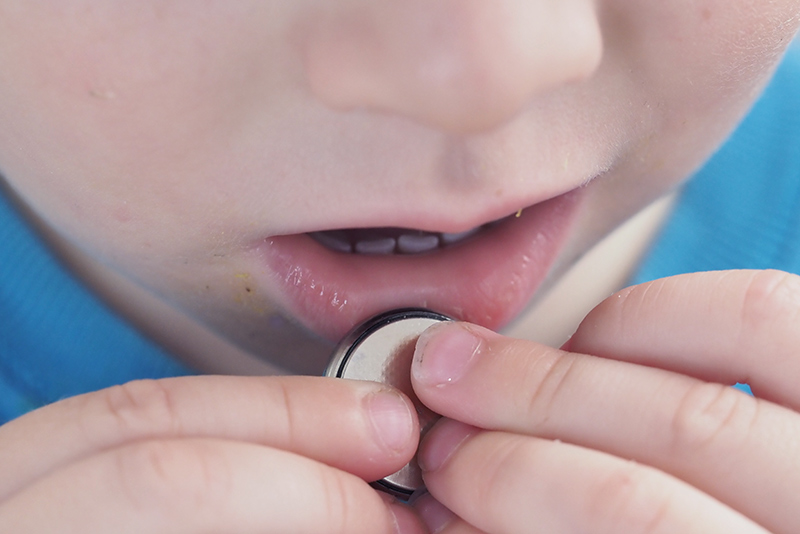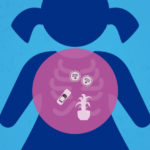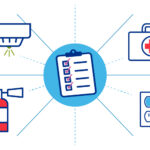Tiny, shiny, and dangerous: What families should know about button batteries

Button batteries may be bright, shiny, and eye catching, but they also have a dark side — especially for kids. Look around your home and you’ll likely find these small discs hiding in plain sight, where they’re used to power everything from watches and scales to remote controls and toys. When curious children encounter them, however, button batteries can pose serious risks, particularly when swallowed. A button battery ingestion is a medical emergency requiring immediate intervention.
The risks of button batteries
Thousands of children ingest button batteries every year. When button batteries come into contact with saliva or other bodily fluids, they generate a current, which in turn produces small amounts of lye, a corrosive chemical also found in drain cleaners and other household products. Lye can burn through the soft tissue of the esophagus and aorta, leading to permanent difficulty eating and drinking, infection, and even death.
It’s a problem that nurse Dori Gallagher knows all too well. As the program director of Boston Children’s Esophageal and Airway Treatment Center, she sees young children with severe and lasting esophageal damage from swallowing button batteries, many of whom have been referred from other hospitals. With other members of the team, she provides long-term follow-up care to children with significant, lifelong complications of button battery ingestion, including those who are unable to eat or drink as a result.
Prevention and education are key to decreasing button battery ingestions — and seeking immediate medical attention can help reduce the harm these batteries can cause. That’s why Gallagher has focused her Nursing Science Fellowship and Doctoral Project on preventing button battery ingestions through education of clinical staff and families and caregivers, aligning with her commitment to patient safety.
“I have witnessed firsthand the damage that can be caused by a button battery ingestion,” she explains. “I’m committed to advocating on the behalf of children to help prevent potentially lethal outcomes.” Here, she shares tips for families.
Prevention is key
The best way to protect your child is to keep batteries out of reach:
- Keep loose and spare batteries in a locked cabinet or box, out of reach or sight.
- Check every battery-powered device in and around your home.
- Make sure that the battery case is shut tight and secured. It’s best to use devices that can only be opened using a tool, like a screwdriver.
- Re-check all battery cases frequently to be sure they stay secure over time.
- Don’t let small children play with devices that might use button batteries.
- Most people don’t realize that a battery that no longer can power a device still has enough power to cause an injury. Be sure to throw away old batteries safely.
Know the signs
Signs that your child has swallowed a battery can be vague and mimic symptoms of various conditions. They may include:
- sudden crying
- drooling
- decreased eating or drinking
- difficulty swallowing
- hoarse voice
- vomiting
- chest pain or discomfort
- abdominal pain
- blood in saliva or stool (poop)
What to do if you suspect your child has swallowed a button battery
Time is critical to reducing harm: If you think your child has swallowed a button battery, take them to the emergency room (ER) immediately. If you believe your child swallowed the battery within the past 12 hours — and if your child is older than age 1 and can swallow liquids — give them two teaspoons of honey and take them to the ER immediately. Inform the emergency department team as soon as you arrive that you believe you child has swallowed a button battery. Research suggests that honey may help form a protective barrier between the battery and soft tissue until your child can be treated. If you have another person with you in the car, give 2 more teaspoons of honey every 10 minutes on the way to the ER.
“Many people are not aware of the dangers of a button battery ingestion, but any delay in seeking care can result in significant harm,” says Gallagher. “Until there are safer packaging regulations, education and awareness are the keys to prevention.”
Startling stats on button batteries
Over the past two decades, there has been a seven-fold increase in the risk of severe injury from button battery ingestions.
Every three hours, a child arrives at the emergency department because they swallowed a button battery.
Emergency room visits related to button batteries and lithium coin batteries nearly doubled during the first several months of the COVID-19 pandemic, as families began spending more time at home.
Learn more about the Esophageal and Airway Treatment Center.
Related Posts :
-

Avoiding a dangerous attraction to magnets: Lainey's story
A few days before Valentine’s Day in 2013, 2-year-old Lainey Styles wasn’t feeling well. She had vomited, was lethargic, ...
-

COVID-19 pandemic may put kids at risk for accidental poisonings
In the effort to keep kids safe from the new coronavirus, families could be unwittingly putting them at risk for ...
-

Childproofing your home: A checklist for parents
Bumps and bruises are a part of growing up. But serious injuries can cause lasting damage. By making a few ...
-

Cannabis edibles: Keep kids safe from adult 'treats'
Candy and chips aren’t necessarily for kids anymore. These days, a chocolate bar, gummy, or bag of cheesy treats ...





